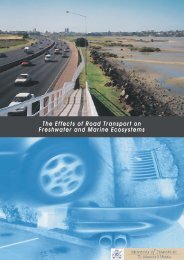National Freight Demands Study - Ministry of Transport
National Freight Demands Study - Ministry of Transport
National Freight Demands Study - Ministry of Transport
Create successful ePaper yourself
Turn your PDF publications into a flip-book with our unique Google optimized e-Paper software.
<strong>National</strong> <strong>Freight</strong> <strong>Demands</strong> <strong>Study</strong><br />
The broad proposals set out in Figures 5.5 and 5.6 demonstrate the priority to be given<br />
to improving the <strong>National</strong> components <strong>of</strong> the State highway network where freight traffic<br />
is likely to be concentrated. SH1 will be improved over almost its entire length on both<br />
the North and South Island, including the possibility <strong>of</strong> almost continuous dual<br />
carriageway between Whangarei and Tirau, and improvements to SH29 connecting to<br />
Tauranga. While freight is only one component <strong>of</strong> the overall demands for the State<br />
highway network, the proposed level <strong>of</strong> road building does recognise the continuing<br />
development <strong>of</strong> the „golden triangle‟ and the growing volumes <strong>of</strong> freight traffic that are<br />
likely to result. The key longer-distance routes into Manawatu from Hawke‟s Bay in the<br />
east and Taranaki in the west are also included in the proposals.<br />
5.2.4 Proposals for urban areas<br />
The discussion above has concentrated mainly on the longer-distance movement <strong>of</strong><br />
freight outside the main urban areas. However, with growing general traffic levels within<br />
the urban areas, congestion affecting both general traffic and freight vehicles is likely to<br />
become more acute.<br />
Within Auckland, congestion levels are having a significant impact on the efficiency <strong>of</strong><br />
freight operations. Anecdotal evidence suggests that the time taken for the movement<br />
<strong>of</strong> freight has typically grown by 20 percent in recent years, and one <strong>of</strong> the courier firms<br />
interviewed indicated that, whereas 10 years ago a courier could achieve 7 round trips<br />
within a working day, in current conditions this had now fallen to 4 trips per day, with a<br />
consequent impact on both the costs <strong>of</strong> the operation and the level <strong>of</strong> service available to<br />
clients.<br />
Within many <strong>of</strong> the urban areas the scope for new road construction is considered to be<br />
limited and the NZ <strong>Transport</strong> Agency is placing increasing emphasis on improved traffic<br />
management. In the short term it is intended that this would be achieved through<br />
measures such as ramp signalling and improved facilities for modes other than private<br />
cars, to encourage users to switch and relieve pressure on the road network.<br />
Within this, some recognition is being given to the needs <strong>of</strong> freight. For the ramp<br />
signalling currently being introduced in Auckland, lanes for freight vehicles to bypass the<br />
signals and gain better access to the motorway are being provided at selected locations<br />
along the motorway. In total it is planned that priority lanes, which can also be used by<br />
public transport vehicles, will be provided at 11 locations on the motorways within the<br />
Auckland Region.<br />
Over the longer term, the NZ <strong>Transport</strong> Agency is considering the provision <strong>of</strong> managed<br />
lanes on which freight vehicles could travel on parts <strong>of</strong> the motorway network in<br />
Auckland, and preliminary work is being undertaken on the development <strong>of</strong> options for<br />
SH16 west <strong>of</strong> the Waterview Connection. It is proposed that alternative locations may<br />
also be investigated at some future date and Transit have included a <strong>Freight</strong> Priority<br />
<strong>Study</strong> in their 10-year programme for the Auckland Region.<br />
Within many urban areas the local road network also plays an important role in the<br />
movement <strong>of</strong> freight, providing linkages to the State highway network from major freight<br />
generators and attractors, and also providing alternative routes. Within these areas the<br />
freight issues are typically dominated by general congestion levels and the desire to<br />
move freight away from road. However, in reality, much local freight traffic within urban<br />
areas has no alternative to road, and may have limited ability to change the times <strong>of</strong><br />
travel. In fact, users <strong>of</strong> private cars have a greater choice <strong>of</strong> mode as they are able to<br />
switch to public transport, walking or cycling.<br />
139
















